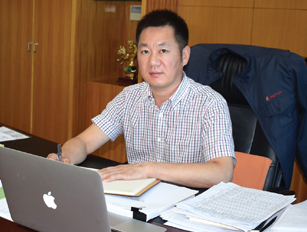
Established in the year 1910, HCA is one of the largest sales service corporations of industrial sewing machines and accessories, in the Indian sub-continent. Being a pioneer in this trade, HCA has all the expertise to solve any garmenting problem through wide and varied knowledge in this field and a nation-wide sales and service network, with a team of trained experienced professionals. HCA has over 10 offices and many dealers and re-sellers of machinery around India, catering to various industries. Today, HCA is sprawling under the guidance of Anil Anand, an Economics Graduate also the 3rd Generation in this business, who has travelled the world to find and learn about the latest available technology, production techniques, from people companies catering to this field, while also training his next generation into this business. In an interview with Apparel Views Editor Arvind Kumar, Anil Anand shares his views about current scenario and future prospects of Indian apparel and textile industry.
How was year 2016 for Indian apparel and textile industry?
It was not very good. When the market was in a process of picking up, all of a sudden at the end of the year demonetisation happened, so it’s after effects are still felt by the industry. People will keep on feeling the pinch because what has happened is not for good. Earlier people were spending very easily, but now they are little bit hesitant, not because they don’t have money in the pockets but the government policies are not very clear. There is no clear cut thinking of what is going to be the outcome of the economy in coming times because of policies not being clear.
India always had free flow of cash in hand, which is the reason why it survived lots of ups and downs in world economy. Since 2008 we have seen economic slowdown in the world but we were not affected because we all had cash. Now, the focus of purchasing has shifted as people are keeping money mainly in banks, which is affecting the domestic market. Besides, last two years were very bad for exports as far as the value is concerned. Last year we saw exports increasing, basically that all happened in South especially in Tirupur, which was responsible for approximately 40 per cent of India’s exports. Due to demonetisation exporters also suffered, as a large percentile of labour force went back to their hometown to convert their money or remaining was standing in the bank lines here. Moreover exporters were not able to pay the daily wages. One of the exporters I met recently was having shipment backlog of 50 days so in next six months he will be spending a lot of money to overcome the same.
How has it been for HCA specifically?
As far as HCA is concerned, though when compared to FY 2015-16, 2016-17 was better but whatever we planned has failed. So, for that planning we invested in so many things but took a negative turn in the last three months. I don’t think we can overcome this in the last quarter. Because of demonitisation domestic market is really hit. Also, there were no winters so again the local market was hit as winters goods were not taken off. The garment factories invest money based on priorities i.e. firstly to pay their labour, second the fabric and raw material suppliers, and we are the last one to get paid. So, our business was affected due to the same.
What as a technology supplier your suggestion to the exporters?
Machinery and manpower is the backbone of our industry. Manufacturers at small and medium scale today are realizing the value of automation and trying to get whatever can fit into their budgets. But one has to be a positive thinker in this industry. It should save where it can and spend where it should be spending. When I talk to exporters, I suggest them to increase their production, with same amount of people by investing in a good automatic technology. They should invest wisely in automatic machines and allocate their Budget in a right sense. Don’t go after brand name or a fancy thing which has no use. Today, 99 per cent of the machines are outsourced by almost many leading brands. So, who are you paying, is that for brand name only. Automation is need of the hour; invest wisely for increasing your productivity with reduced manpower.
Could you please update us on the global apparel market trend?
China’s manufacturing of garments is decreasing due to very high labour costs. But everywhere else, it is increasing, as the work from China is shifting to the other three countries due to depreciated currencies and cheap and abundant labour. Cambodia has made a new resolution that they will be working 250 days in a year. So their work is going to shift either to Pakistan or India. However, India is on brighter side and the new breed of exporters is very positive. Earlier exporters didn’t want to migrate on the areas which were not developed. Today, some of them have taken the lead by going to backward areas. But we have to create better infrastructure as the govt. is not able to provide the same. Nobody has helped this industry, all the credit goes to garment exporters for making it a success story. Otherwise, you have not got any kind of help from the govt.
Why do you think Bangladesh is performing better than India in garment exports?
Today automation sells much more in a bigger way in Bangladesh than India. In India still people are doing old conventional ways than to think about new technologies. Bangladesh is very acceptive, they always look forward to new technologies and want to implement them. They mostly have specialised product based factories which is the reason behind them doing really well. Even in India, if you go to South e.g. Tirupur is growing just because they have product based factories.
India just lives on value addition especially exporters in Northern India. We cannot make much money out of basic garments, which are cheaper in Bangladesh. So, we have to have value addition. Day-by-day completion is increasing and everything here is becoming expensive. Today cost of land in Northern India is 20 times more what you pay outside Bangalore, also the cost of labour force is increasing.
What are your expectations from the govt. for further growth of this industry?
Make the government process easier. Government may introduce schemes and subsidies but to get them is a hell of a task. As a manufacturer we need to concentrate on work and how to increase it and not how to keep on increasing paper work. If you want to make it a paperless economy, this is where we need to start. At the same time I expect the import duty on the automatic garment machinery used for export or domestic should be reduced as we are not making such machines in India. Looking forward for better support from the tax authorities as well.
How do you see 2017 for the industry?
2016 had been good and work is getting better, but we still have lots and lots more to do. For apparel manufacturing fraternity, there will not be much scope in Delhi NCR so they will have to migrate in other areas. Demand for more automated machinery, that can increase productivity and deskill the workforce, has been increasing for last two years. Exports are growing in India, and so is the domestic consumption. Moreover, India has raw material base and lots of labour force so in long term garment trade is going to flourish a lot. We all will have bright future ahead.

















